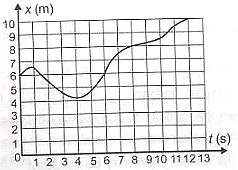A boy standing on a stationary lift (open from above) throws a ball upwards with the maximum initial speed he can, equal to \(49~\text{ms}^{-1}.\) How much time does the ball take to return to his hands?
1.
\(5\) s
2.
\(10\) s
3.
\(15\) s
4.
\(7\) s
On a long horizontally moving belt (as shown in the figure) a child runs to and fro with a speed (with respect to the belt) between his father and mother located 50 m apart on the moving belt. The belt moves with a speed of . For an observer on a stationary platform outside, what is the speed of the child running in the direction of motion of the belt?

1. 5 kmh-1
2. \(\sqrt{41}\) kmh-1
3. 21 kmh-1
4. 13 kmh-1
A passenger arriving in a new town wishes to go from the station to a hotel located \(10~\text{km}\) away on a straight road from the station. A dishonest cabman takes him along a circuitous path \(23~\text{km}\) long and reaches the hotel in \(28~\text{min}.\) The average speed of the taxi is:
1. \(30~\text{km/h}\)
2. \(49.3~\text{km/h}\)
3. \(55.6~\text{km/h}\)
4. \(60~\text{km/h}\)
A particle moves along the x-axis with a speed 6 m/s for the first half distance of a journey second half distance with a speed 3 m/s. The average speed in the total journey is
(1) 5 m/s
(2) 4.5 m/s
(3) 4 m/s
(4) 2 m/s
A car moves with a speed of \(60\) km/h for \(1\) hour in the east direction and with the same speed for \(30\) min in the south direction. The displacement of the car from the initial position is:
| 1. | \(60\) km | 2. | \(30 \sqrt{2}\) km |
| 3. | \(30 \sqrt{5}\) km | 4. | \(60 \sqrt{2}\) km |
A person travels along a straight road for the first time with a speed v1 and for next time with a speed v2. Then the mean speed v is given by
(1)
(2)
(3)
(4)
The figure shows the graph of the x-coordinate of a particle moving along the x-axis as a function of time. Average velocity during t=0 to 6 s and instantaneous velocity at t=3 s respectively, will be:
1. 10 m/s, 0
2. 60 m/s, 0
3. 0, 0
4. 0, 10 m/s
Position-time graph for a particle is shown in the figure. Starting from t=0, at what time t, the average velocity is zero?

(1) 1 s
(2) 3 s
(3) 6 s
(4) 7 s
| 1. | zero velocity. | 2. | zero acceleration. |
| 3. | non-zero velocity. | 4. | non-zero acceleration. |
If a particle is moving along a straight line with increasing speed, then:
| 1. | its acceleration is negative. |
| 2. | its acceleration may be decreasing. |
| 3. | its acceleration is positive. |
| 4. | both (2) & (3) |







